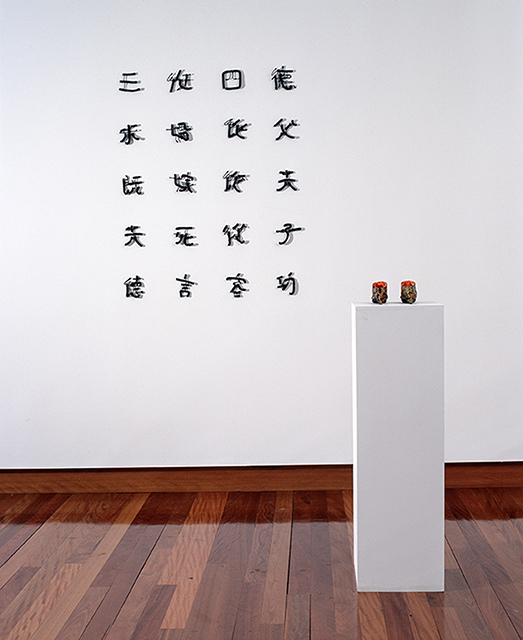


Kate Beynon is part of a generation of Asian–Australian artists whose practice dovetailed with Australia’s political and cultural engagement with Asia in the 1990s. Like Lindy Lee, Beynon draws on her Chinese ancestry in works that address issues of race, language and gender.
Classics for girls (1996) is an example of the installations that first established Beynon's reputation, in which found Chinese texts, shaped with chenille sticks, are accompanied by objects, often versions of the miniature shoes used in the now outmoded practice of footbinding. In some works the artist combined Chinese calligraphy with western punctuation; in this work, the text is taken verbatim from a sixteenth-century Chinese deportment manual for girls. However, since it is drawn with feathery-edged chenille, the text is literally fuzzy. The artist herself cannot read Chinese, and many Chinese-speaking people have commented that they have been unable to decipher her calligraphy. Perhaps this difficulty of reading is exactly the point—the words are not intended to be entirely legible. Rather, they are cryptic pictograms made in homage to the artist's maternal Chinese ancestry, experiments in the drawn shapes of calligraphy. 'I have always been interested in decorative symbols and logos on clothes and textiles,' the artist has said. 'The text can be read in terms of language as well as illustration.'1 As Stuart Koop has so eloquently described, Beynon’s blurred text translates as a kind of cultural dyslexia, 'a beautiful and strange writing which symbolises or perhaps even pictures the alienation of minority cultures'.2
The self-conscious acquisition of an ancestral culture into which one is born, but of which one is ignorant, is a hallmark of contemporary Australian experience. Beynon took up an Asialink residency in China in the mid-1990s, a return to a home to which neither she nor her mother (who was born in Malaysia and lived in Hong Kong before emigrating to Australia) had ever been.3 This vicarious relationship with an inherited culture raises awkward questions: To what extent is the artist, who has never lived in China or Malaysia, able to speak about the role of women in China? Moreover, because of the narrow application of a practice like footbinding within an Australian context, Beynon treads a fine line between her work being reducible to its sources—a fascination with her genealogy—and being able to make wider statements about cultural identity in a multiracial society. But perhaps this is also the work’s strength: in addressing not only Australian but Chinese issues, Beynon's work attains a confusing ambiguity in which taking sides is neither clear nor possible.
With the dissolution of multiculturalism as an accepted Australian ideal, the very term racism has been called into question, neutered as part of the derided category known as the 'politically correct'. Where during the 1990s works addressing racial issues might have been seen as being part of a bureaucratic ideology, with the changed climate of the past few years such works have taken on a more subversive or adversarial role. Recently, Beynon has developed a contemporary animated character, Li Ji: warrior girl, who negotiates racism and misogyny while time-warping between fourth-century China and twenty-first-century Melbourne—a more aggressive messenger for an age in which little can be taken for granted.
- Hannah Fink
Kate Beynon is represented in Australia by Sutton Gallery, Melbourne.